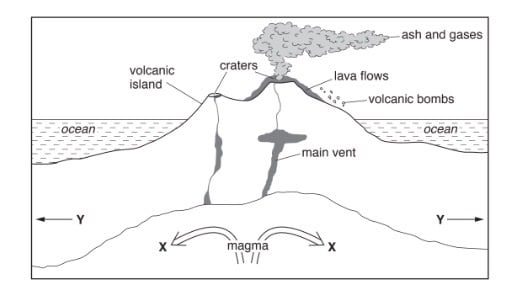Causes of Earthquakes & Volcanic Eruptions
The structure of the Earth
- The Earth is composed of four main layers
- Inner core - about 1400km in diameter, a solid and dense layer composed of iron and nickel with temperatures of about 5500oC
- Outer core - about 2100km thick, a semi-molten metal layer with temperatures between about 5000-5500oC
- Mantle - about 2900km thick, a semi-molten layer which is less dense than the outer core
- Crust - the thickness varies and it is made up of two types of crust

Structure of the Earth
Crust
- There are two types of crust
- Continental crust is thick (25-90km), old and not as dense as oceanic crust
- Oceanic crust is thinner (5-10km), heavier and denser than continental crust
- Oceanic crust is continually being created and destroyed as a result of plate movement where it is denser and so subducts under the continental crust
Plate tectonics
- The crust is broken into a number of tectonic plates

Tectonic Plates
- These plates move on top of the semi-molten mantle below.
- The movement of the plates is in part due to the convection currents within the mantle
- A plate boundary or margin is where two plates meet
Types of plate boundary
- Volcanic eruptions and earthquakes most commonly occur at or near plate boundaries
- There are four main types of plate boundaries:
- Divergent (constructive)
- Convergent (destructive)
- Collision
- Transform (conservative)
Divergent (constructive) plate boundary
- At a divergent boundary the plates are moving apart
- The Mid Atlantic Ridge is an example of a divergent plate boundary
- Both volcanic eruptions and earthquakes can occur at this type of plate boundary

Divergent (constructive) plate boundary
Convergent (destructive) plate boundary
- At a convergent (destructive) plate boundary the plates are moving towards each other
- The denser, heavier oceanic plate subducts under the lighter, less dense continental plate
- The boundary between the Nazca plate and the South American plate is an example
- Both volcanic eruptions and earthquakes occur at this type of plate boundary

Convergent (destructive) Plate Boundary
Collision boundary
- At a collision boundary two plates of similar density move towards each other
- Neither is dense enough to subduct, so the land is pushed upwards
- This forms fold mountains such as the Himalayas
- Earthquakes are the main hazard at this type of plate boundary

Collision Boundary
Transform (conservative) boundary
- At a transform (conservative) boundary the plates move passed each other in opposite directions or in the same direction at different speeds
- Earthquakes are the only hazard at this type of boundary

Transform (conservative) Boundary
Worked example
Study Fig 1, which is a cross-section through a volcano.
[1]

Fig 1
(i) What type of plate boundary is shown in Fig 1?
- Answer:
- Constructive/divergent [1]
(ii) Choose the correct labels for features X and Y shown in Fig 1.
Choose from the list below:
- convection currents
- direction of plate movement
- lava escaping from the volcano
- new crust created
- subduction
- Answer:
- X = convection currents
- Y = direction of plate movement
Exam Tip
Draw each of the plate boundaries and add annotations to outline the processes. This will help you to remember what happens at each one.



